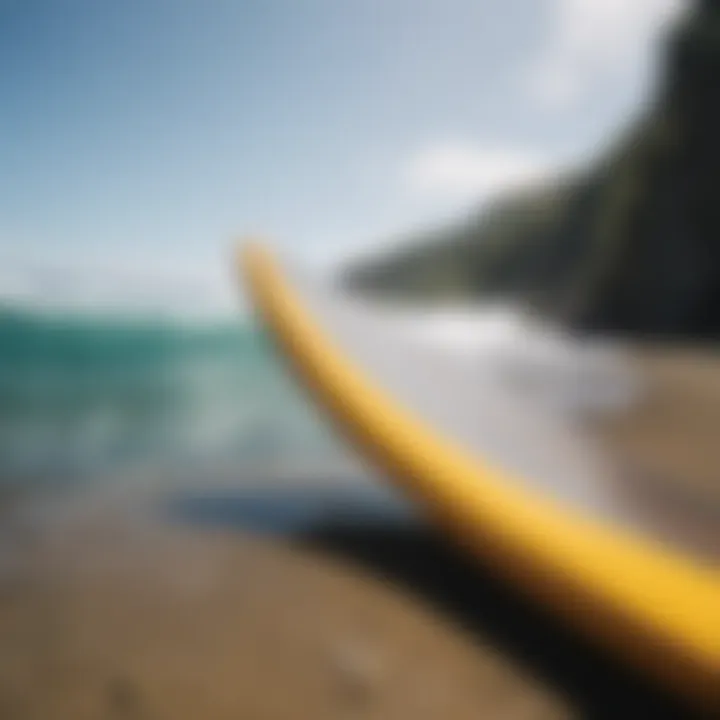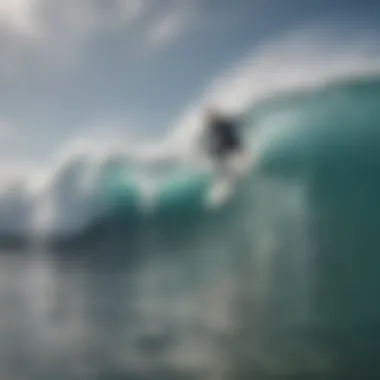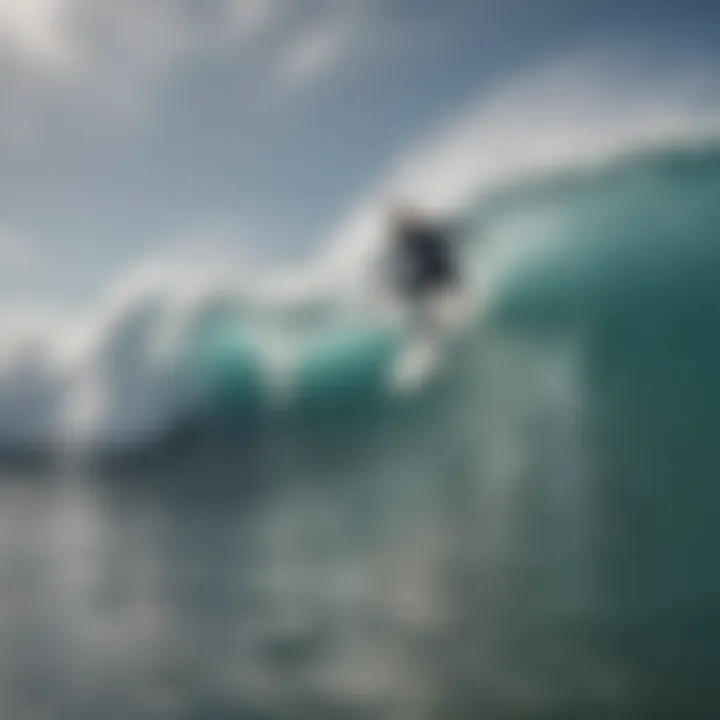Understanding Fins: Key to Surfboard Performance


Intro
When one glides over the waves, the surfboard serves as a crucial tool. But have you ever thought about what really makes the board respond as you expect? Enter the fins. Often overlooked by novices, fins play a pivotal role in determining how a surfboard behaves on the water. From the type, shape, and position of the fins to the material they’re made from, these characteristics can elevate the surfing experience or set limitations that hinder performance.
Techniques and Skills
In the realm of surfing, mastering techniques while understanding how fins affect your board is vital. With the ocean as your playground, the right fin setup can make all the difference.
Fundamental Techniques for Beginners
For those just dipping their toes into surfing, grasping basic maneuvers is essential.
- Paddling: Your fins provide stability as you paddle out. The wider the tail and the fin size, the more buoyant the board will feel, allowing for smoother paddling.
- Standing Up: Once you pop up, your feet should ideally be near the fins; this positioning helps maintain balance. The surfboard's behavior might shift based on whether you are using a thruster setup or a single fin.
- Turning: The angle and length of the fins affect turning radius. While short, upright fins can assist in quick turns, long fins enable smoother, more powerful carving.
Advanced Skills for Experienced Athletes
For those who have ventured beyond the beginner stage, refining technical skills becomes paramount. Masters of the art can take advantage of specific fin setups to enhance their performance further.
- Duck Diving: Understanding how your fins affect the underwater profile of your board is crucial. A narrower tail with smaller fins cuts through the wave more seamlessly.
- Carving: Using thinned-out and flexy fins can provide a dynamic feel, allowing surfers to lean into powerful turns while maintaining control through edge-to-edge transitions.
- Aerial Moves: The fin placement can impact your lift and landing. A quad setup, for instance, can offer more acceleration off the lip for those daring flips.
Understanding Fin Types and Setups
Diving deeper into the world of fins, there are multiple types with unique influences on performance.
- Single Fin: Great for traditional longboards, ideal if you're looking for a steady ride.
- Thrusters: This three-fin setup strikes a balance between speed and maneuverability, often favored by modern shortboard surfers.
- Quads: With four fins, this setup excels in speed and stability but takes a bit of finesse to master during turns.
Fin material also plays a role in performance. Why does this matter? Plastic fins are sturdy but tend to flex. On the flip side, fiberglass fins, while more fragile, provide a terrific responsiveness that many advanced surfers crave.
"The right fins, they say, can transform a surfboard into an extension of your own body."
Safety and Gear
Every surfer knows that while the waves are calling, safety can't take a back seat. Making sure you have the proper equipment not only boosts performance but also protects you from accidents.
Essential Safety Measures in Watersports
As you navigate through the waters, keep these few safety tips in mind:
- Wear a Surf Leash: It keeps your board close in case you wipeout, letting you swim safely back to it.
- Understand the Environment: Know the local tides and currents to surf safely.
- Use Proper Sunscreen: Sun protection should also be high on your list!
Gear Reviews and Recommendations
The right gear can elevate your experience in the surf. Whether you’re after the perfect wetsuit or a new surfboard, reviews from seasoned surfers can guide your purchases.
- Fin Systems: For example, the Futures or FCS systems allow fin interchangeability, letting you experiment until you find the perfect match for your surfing style.
- Foam Boards: Great for beginners, these boards offer added buoyancy and stability while you learn the ropes.
In wrapping up this discussion on fins, remember that understanding their function can transform not just your surfboard but your entire experience in the water. With the right knowledge and setup, you’ll be riding those waves with newfound confidence.
Understanding Surfboard Fins
To truly grasp the world of surfing, it's essential to understand surfboard fins. These seemingly simple components play a pivotal role in shaping not just the performance of the board, but the entire surfing experience. Fins are not just an accessory; they are fundamental to how a board behaves in the water. Not only do they provide stability and control, but they also enhance maneuverability, making it easier for surfers to carve through waves or maintain speed. By delving into the intricacies of fins, one can appreciate their influence on ride quality and adaptability to various surfing conditions.
Definition and Functionality
Fins are extensions located at the bottom of a surfboard. They serve several critical functions that affect how the board interacts with water. Primarily, they aid in directional control. By cutting through the water, fins prevent the board from sliding out sideways, which is crucial when making turns. Think of them as a car's wheels on a road; they help steer and stabilize when navigating through turns and maneuvers.
The size, shape, and placement of fins significantly impact how a board behaves. For instance, a longer fin might provide better directional stability, ideal for straight-line riding, while a shorter fin might enhance looseness and allow for quick turns. Additionally, fins also affect the speed of the board. A thinner fin can create less drag, contributing to a faster ride. Therefore, understanding fin functionality is key for any surfer looking to optimize their surf experience.
History of Surfboard Fins
The development of surfboard fins has come a long way since the early days of wave riding. Fins as we know them today weren't always around. In the 1930s, when surfboards were made from solid wood, they functioned almost as floating planks. These early designs did not include fins. Surfers relied on their balance and skill to maintain direction.
However, the introduction of fins in the 1940s marked a turning point in surfing design. The ability to maneuver and control the board revolutionized the sport. The first fins were primitive and often just large chunks of wood or metal attached to the board's bottom. Over time, as surfboards transitioned to foam and fiberglass, fin designs evolved. The introduction of the fiberglass fin in the 1960s led to a hybrid of performance enhancements that surfers thrive on today.
Today, with modern technology, fins are crafted in a variety of shapes, sizes, and materials. Each variation is designed to cater to different styles of surfing and wave conditions, reflecting an ever-evolving dialogue between surfers and their boards.
Types of Surfboard Fins
Understanding different types of surfboard fins is crucial to maximizing performance and enhancing the surfing experience. Each fin configuration caters to specific surfing styles and conditions. Choosing the right fin can significantly affect maneuverability, stability, and even speed in the water. Therefore, it’s important for surfers to familiarize themselves with these options. Here’s a closer look at the most common types of fins and their benefits.
Single Fins


Single fins were the traditional choice for surfboards, packing a lot of performance into a simple design. This setup is characterized by a single fin placed at the tail of the board. One of the best features of single fins is their smooth turnability. Surfers often find that maneuvering in smaller, softer waves feels effortless. The takeaway? They’re perfect for laid-back surfing, or when you want to enjoy a mellow session on water that isn’t aggressive.
Though they offer stability, it’s critical to note their limitations. Relying solely on a single fin in bigger, choppier conditions can lead to a lack of control. Therefore, single fins are best suited for more relaxed settings where graceful carving and flow take the front seat.
Twin Fins
Twin fins take inspiration from the single fin design and add another fin to the mix. Typically, these fins are placed side by side at the board's tail, creating a wider surface area. This setup is known for enabling quick acceleration and providing a lively response. They work wonders in smaller, fast, and punchy waves, going where the surf guides.
The benefits of twin fins extend to their ability to loosen up the board for a more playful experience, allowing surfers to execute tricks and maneuvers. Plus, they deliver a unique sensation of speed and glide, giving surfers the thrill they often chase. Just a caveat—the twin fin setup might lack stability in heavy, turbulent waters, which means surfers should keep those conditions in mind while choosing.
Thruster Fins
Thruster fins have become the gold standard in the surfing world, and rightly so. The classic three-fin setup—one center fin with two side fins—offers a balance of speed, maneuverability, and stability. This fin arrangement allows for tighter turns while maintaining control. When you talk about performance across a variety of wave conditions, thruster fins shine particularly bright.
Versatility is the name of the game here. Whether you're shredding down the line on a fast wave or slashing through the lip of a bigger swell, thruster fins can adapt. They provide adequate drive while keeping the board glued to the water in more aggressive moves. As a result, this configuration is frequently seen under the feet of both professional and amateur surfers.
Quad Fins
A quad fin setup introduces a combination of speed and stability that many surfers find irresistible. With four fins positioned along the tail, this configuration excels in heavier waves. Quad fins often give a board a more significant surface area, ensuring that riders get enhanced control and quicker response times. If you're looking to maintain speed through turns, these fins may just be your best bet.
Another appealing aspect is how they allow surfers to carry speed when making transitions and changing directions. The catch? Sometimes, surfers may have to sacrifice a bit of maneuverability when compared to thruster setups, but if it’s speed you’re after, then quads deliver.
Five Fin Setup
The five fin setup provides endless possibilities and versatility for those who like to switch things up in the water. This system allows surfers to choose any combination of fins—be it a quad, thruster, or even single setup—tailored to the specific conditions and personal preferences. By loosening or tightening the fins, surfers can directly influence how their board behaves in different types of waves.
While this setup may appeal to adventurous surfers wanting freedom to experiment, it is essential to be mindful of the board's overall design and intended use. More fins don’t always mean better rides; the right choice ultimately revolves around individual surfing style and comfort.
"The fin choice can make or break how you experience each wave. It is about knowing your needs and what you want from the session."
Understanding these fin types can lead to major improvements in your riding experience. Whether you prefer the relaxed flow of a single fin or the adventurous thrill of a five fin setup, knowing the ins and outs helps elevate your surfing game.
Materials Used in Surfboard Fins
Understanding the materials utilized in surfboard fins is crucial for both performance and longevity. The choice of material affects the fin's flexibility, strength, and buoyancy, all of which play a significant role in a surfer's experience. As surfers, we often focus on the shapes and setups of fins, but it's essential not to overlook how the materials contribute to overall functionality. Each type offers distinct advantages that resonate with a surfer's style, the waves they ride, and their preferences in maneuverability.
Fiberglass Fins
Fiberglass fins have been a long-standing favorite among many surfers. When it comes to performance, they blend strength with lightweight characteristics. Fiberglass can be molded into various shapes, allowing for personalization that suits diverse surfing techniques.
The flexibility of fiberglass fins strikes a balance between rigidity and give, often resulting in a smooth ride. These fins tend to be durable, standing up well to the wear and tear of the ocean environment. Yet, they do have a notable downside: they can chip or break under extreme pressure.
Key Benefits:
- Excellent strength-to-weight ratio
- Suitable for custom shapes
- Smooth flow through the water
However, maintaining fiberglass fins might require more attention. Regular inspections for chips or cracks can help prevent issues before they affect performance.
Plastic Fins
Plastic fins are often viewed as the entry-level option, making them a common choice for new surfers. They are generally affordable and relatively sturdy, which is why they appeal to those just starting their journey on the waves.
Though plastic fins may not provide the same high-performance feel as fiberglass or carbon fiber counterparts, they have their merits. They can be less prone to breaking, making them a safe bet for those still getting acclimated to board control. However, their flexibility can vary significantly, which can impact how well they'll respond in challenging conditions.
Key Benefits:
- Cost-effective
- Resilient to some extent
- Good for inexperienced surfers
Nevertheless, their weight can sometimes be a drawback, as they can create drag. This makes an understanding of weight and fin placement essential for those wanting to maximize their surf performance.
Carbon Fiber Fins
Now, we delve into premium territory with carbon fiber fins. These fins are the crème de la crème when looking for a combination of strength, flexibility, and responsiveness. Surfers who prioritize competition often lean toward carbon fiber for their advantages in speed and maneuverability.
Carbon fiber fins are remarkably rigid, providing excellent thrust and quick response when carving through waves. However, the stiffness might not be suitable for everyone, particularly if a surfer prefers a softer feel.
Key Benefits:
- Outstanding responsiveness
- Lightweight yet strong
- Enhanced speed and agility
Yet, it is essential to approach carbon fiber fins with a sense of caution. They can readily fracture under extreme stress, and replacement could be quite an expense. Surfers must weigh their choices against their riding style and conditions.
The Impact of Fins on Surfboard Performance


Fins serve as the critical bridge between a surfer and the water, profoundly influencing how a surfboard behaves. Understanding fin design is essential for surfers who want to enhance their abilities and maximize performance. To excel in the water, knowledge about how different fin setups affect maneuverability, speed, and stability becomes vital.
Maneuverability
Maneuverability in surfing always translates to a rider’s ability to perform tricks, carve turns, or adjust direction swiftly in changing conditions. Fins are fundamental in this aspect. A design with a larger surface area tends to offer more grip on the wave but may limit quick turns, whereas smaller fins promote a looser feel, often preferred for aerials and tight turns.
Surfboard enthusiasts often find themselves torn between these options. For example, in conditions where agility is paramount—such as during a competition phase in smaller waves—a thruster setup can provide the needed balance between grip and freedom of movement. The three fins allow for a sharper turn, pushing the board quickly along the wave face and aiding in more dynamic transitions.
On the flip side, utilizing a single fin, which has been a classic choice for traditional longboarding, might offer a smooth, fluid carving experience. Yet one may find it lacks the explosiveness found in more contemporary setups.
"The right fin configuration can mean the difference between a stylish maneuver and a wild tumble into the water."
Speed
When it comes to speed, fins play a dual role of aiding in acceleration and ensuring a streamlined ride. A well-designed fin setup effectively cuts through water, allowing a surfer to paddle faster and generate speed more efficiently once on the wave. Thinner and longer fins usually offer reduced drag and are instrumental in boosting straight-line speed.
Surfers often gravitate toward quad fin setups when high-speed rides are their aim. This configuration spreads the load across four fins, providing balanced lift while maintaining control at high velocity. Images splashed across social media effortlessly depict a board cutting through barreling waves—often these setups are behind that speed, granting the rider a thrill only possible with the right fin design.
Stability
Stability is a fin's ability to keep the surfboard balanced on the water's surface, significantly impacting how a surfer feels while riding a wave. A stable board instills confidence in a surfer, allowing them to push their limits without fear of losing control.
Several factors influence the stability of fins, including the width and shape. Wider fins generally create a more stable ride, as they provide additional surface area for water displacement. This is highly beneficial in larger swells where balance is critical. Surfboards with a five-fin setup can adaptively respond to varying conditions, offering the versatility a surfer may need.
Conversely, a narrower fin might sacrifice some stability but makes up for it with an ability to turn more sharply. It’s crucial for surfers to consider this trade-off based on their environment and riding style.
Understanding the intricate relationship between fin design and performance is indispensable for anyone serious about surfing. When the right fin is chosen, it not only enhances maneuverability, speed, and stability but also elevates the overall surfing experience.
Choosing the Right Fin Setup
Surfboard fins are not just some little appendage glued to the bottom of your board. They're crucial players in the game of surfing, influencing everything from speed to control. Getting the fin setup right caters to your wave conditions, personal surfing style, and skill level. It’s like trying on a new pair of shoes; they should fit well and suit the activity you're partaking in.
Assessing Wave Conditions
When it comes to wave conditions, knowing the type of waves you’ll be tackling can steer your fin choice. Different setups perform better in various scenarios. For instance, in choppy waves, a thruster fin setup offers greater stability and helps maintain control when the ocean gets restless. If you’re surfing on glassy, well-formed waves, maybe opt for a quad fin setup to take full advantage of speed and agility.
- Small Waves: Consider a twin fin setup that allows for smoother, more playful maneuverability.
- Medium Waves: Perfect for a thruster, balancing performance and control when surfing faster breaks.
- Large Swells: A quad fin might just be your best friend, as it provides excellent lift and resistance to stronger forces.
"Understanding wave conditions can make or break your session. Choose wisely for a better ride!"
Surfing Style and Preferences
Your personal style and preferences also play pivotal roles in selecting your fin setup. Are you a smooth cruiser, or do you lean more towards aggressive maneuvers? Someone who thrives on vertical snaps may prefer a more rigid fin setup. For those who favor a relaxed style, a looser fin option can allow for fluid carving.
- Traditionalists might gravitate towards single fins that provide a nostalgic feel with glide.
- Freestylers often enjoy the flexibility of twin fin setups, as they whip around more easily.
- Performance surfers may find they excel with a thruster configuration, offering a great mix of speed and control.
Skill Level Considerations
Your surfing skill plays a fundamental role in fin selection. Beginners often benefit from setups that enhance stability and make it easier to learn. A wider base fin setup can help with balance and control. On the other hand, seasoned surfers might choose more advanced options to further refine their performance.
- Beginner: A single fin or wide base fin provides added stability for those still working on their balance and techniques.
- Intermediate: A thruster can enhance maneuverability as skills grow and the surfer becomes more comfortable tackling challenges.
- Advanced: High-performance fins like quads or five-fin setups will likely attract those looking for precision in sharper turns and high-speed rides.
Choosing the right fin setup is part art and part science, molded by the water conditions, your surfing style, and your level of expertise. Understanding how these elements intertwine ultimately creates a more tailored, enjoyable surfing experience.
Fins and Environmental Considerations
The design and function of fins in surfboards extend beyond enhancing performance; they also intersect closely with environmental concerns. Surfers increasingly recognize their responsibility in protecting the marine ecosystems that provide their playground. Examining how fins relate to sustainability and marine life can spotlight the broader implications of surfboard design. For both new and seasoned surfers, these considerations can influence their choices, ultimately helping them ride the waves more conscientiously.
Sustainability in Materials
When it comes to surfboard fins, the materials used can significantly impact environmental sustainability. Traditional fins might be made from materials that are not the most eco-friendly. However, the surf industry has begun to embrace alternatives that are less harmful.
Fins made from sustainable materials, such as recycled plastics, plant-based resins, and even bamboo, help lessen the industry's carbon footprint. Using these materials not only decreases reliance on fossil fuels but also promotes sustainable harvesting and reduces waste.
Benefits of Sustainable Fin Materials
- Less plastic waste: By switching to biodegradable or recycled materials, manufacturers can help diminish the overall plastic pollution in oceans.
- Resource conservation: Using renewable resources can keep non-renewable materials in the ground, allowing for a more balanced ecosystem.
- Eco-conscious branding: Brands adopting sustainable practices often attract environmentally aware consumers, cultivating a loyal customer base.
A shift in philosophy among surf brands is moving toward materials that minimize ecological footprints. Surfers are likely to feel a sense of pride, knowing their equipment supports the environment rather than harms it.
Impact on Marine Life


The choice of fins, while seemingly minor, can also affect marine ecosystems. Surfers may not think about the potential ramifications of fin design and materials on the ocean's delicate balance, but they are significant. For instance, rigid fins made from synthetic materials can cause harm when lost in the ocean. These items contribute to the ever-growing problem of marine debris, threatening wildlife that may mistake them for food.
Furthermore, surfsport practices impact habitats. Fins designed to reduce drag and improve performance can help surfers maneuver better, potentially minimizing their time spent in sensitive areas of the ocean.
Considerations for Protecting Marine Life
- Opt for eco-friendly fins: Choosing fins made from biodegradable or recycled materials can help limit ongoing pollution.
- Practice responsible surfing: Knowing where to surf and avoiding sensitive coral or sea grass areas can further lessen one's impact on marine ecosystems.
- Stay informed: Engaging with surf communities that emphasize environmental activism can bolster awareness about how our choices affect marine wildlife.
"Environmental stewardship is not just a choice; it is a necessity for future generations of surfers to enjoy the waves as we do today."
Maintenance of Surfboard Fins
Maintaining surfboard fins is critically important for any surfer who wants to get the most out of their rides. Fins play a significant role in how a board performs on waves, and keeping them in top shape can noticeably enhance stability, speed, and maneuverability. Just like you wouldn't drive a car with worn-out tires, surfing with poorly maintained fins is a shortcut to disappointment. Understanding how to inspect, repair, and store your fins properly can extend their life and keep your surfing sessions productive.
Inspections and Repairs
Regular inspections of fins should be a key part of a surfer's routine. After all, fins can face quite a bit of punishment as they slice through waves. Look for any cracks or chipping, which can occur due to impacts with rocks or being dropped. A simple visual check can help catch potential problems before they worsen. If any damage is spotted, repairs should be made promptly.
Common repairs can be as easy as applying a patch of epoxy on minor cracks or replacing a fin altogether if it's too far gone. Ensuring that screws and plugs are tight and free of rust is also vital, as loose fittings can lead to fins popping off mid-ride, ruining your day and possibly causing injury. Here are a few helpful pointers for inspection:
- Check for cracks: Inspect each fin from different angles.
- Look for water damage: Fins should be dry; moisture build-up can weaken materials.
- Inspect screws and fittings: Ensure they're snug and not corroded.
If damage to your fins is more severe, it may be wise to consult a professional at your local surf shop, who can offer expert advice or service. Regular maintenance means better performance, so don’t skip over this step.
Storage Recommendations
Where and how you store your fins can significantly affect their lifespan. Improper storage can lead to scratches, bends, or even breakage, all of which compromise the functionality of these crucial components. Here are a few recommendations for storing your fins properly:
- Use a dedicated fin bag: Keeping fins in their own padded bag helps protect them from sharp objects and prevents chipping.
- Avoid exposing fins to harsh conditions: Prolonged exposure to UV light can weaken some materials, while extreme temperatures can cause warping.
- Keep fins dry: A wet fin left unchecked can develop mold or rust on screws, leading to potential damage.
Taking these precautions can ensure that fins remain in excellent shape, ready for your next adventure on the water. By being mindful of maintenance and proper storage, surfers can greatly enhance their performance while also prolonging the life of their gear.
"An ounce of prevention is worth a pound of cure." - Benjamin Franklin
In summary, maintaining surfboard fins involves regular inspections, timely repairs, and proper storage strategies. These practices can go a long way in ensuring that every surfing experience meets your expectations and lives up to the potential of your board.
Trends in Fin Technology
As surfing continues to evolve, so does the technology behind surfboard fins. The importance of keeping pace with the latest trends in fin technology cannot be overstated. It relates directly to how surfers can optimize their performance on the waves. With new advancements, fins not only serve their basic function of providing control but also enhance aspects like speed, stability, and maneuverability.
One significant trend in fin technology is the drive towards customization. Surfers are increasingly looking for fins that can be tailored to personal preferences and surfing styles. A fin that might work wonders for one surfer may not suit another’s technique or the conditions they ride in. This gives rise to a demand for modular fin systems, allowing surfers to mix and match fins based on the wave type or surfboard they’re using.
This customization goes hand-in-hand with the rise of smart technology in fin design. Innovations like embedded sensors can now track a surfer’s movements on the board and relay data to apps for real-time analyses. This paves the way for surfers to refine their techniques based on tangible feedback about their performance, something that was unheard of a few years back.
Innovative Designs
The evolution of fin shapes has led to innovative designs that cater to different environments and skill levels. The more recent developments include asymmetrical fins or specialized wings, enhancing performance by significantly altering how a surfboard interacts with waves. These designs help in enhancing the water flow around the fins, allowing for tighter carves while maintaining speed.
For instance, some modern designs introduce cutouts or geometrical shapes that allow water to move freely over and under the fin. This creates less drag and provides surfers with the ability to pivot and change direction more easily, contributing to more fluid movements on the water.
To summarize, the wave of innovative designs not only boosts performance metrics but also provides a chance for surfers to express their individuality on the waves. It’s common for experienced surfers to carry different fins just to adapt to varying surf conditions, symbolizing their understanding of how intricate fin designs affect ride dynamics.
Future Materials
Looking ahead, the materials used in fin manufacture are seeing a substantial shift as well. Traditional fiberglass fins are now being challenged by more advanced and eco-friendly alternatives like bio-resins and recycled plastics. These materials are not only lighter but also strong, adding a new layer of performance advantage without compromising environmental responsibility.
Carbon fiber fins, while being a favorite among competitive surfers due to their rigidity, have begun to integrate elements from sustainable design principles. This dual approach aims to create fins that are both high-performance and less harmful to the ocean environment.
Future materials could also see the emergence of self-repairing technologies, potentially expanding the lifespans of surfboard fins. The prospect of materials reacting to damage and repairing themselves signifies a major leap towards durability.
"As we focus on reducing our environmental footprint, the blending of performance with sustainability will shape the future of fin technology."
Surfers should keep an eye on these trends as they can massively influence not only their technical capabilities but also their overall experience riding waves. By understanding these developments, a surfer can truly make informed choices that enhance their time and performance in the water, allowing them to ride the waves more effectively than before.
Closure
In summation, the role of fins in surfboard design cannot be overstated. As we’ve delved into throughout this article, fins play an essential part in determining how a surfboard performs in various conditions. The choice of fin setup directly affects factors like maneuverability, speed, and stability. A well-selected fin can mean the difference between a smooth ride and an arduous struggle against the waves.
Summarizing Key Points
Understanding the intricacies of surfboard fins involves examining various parameters such as:
- Types of Fins: Each fin type, be it single, twin, thruster, quad, or a five-fin setup, brings its unique advantages, tailoring the surfing experience according to the surfer’s skill level and preferred style.
- Materials: The material composition of fins plays a pivotal role in both performance and durability. Fiberglass offers flexibility, while carbon fiber provides rigidity and responsiveness, leaning towards different surfing styles.
- Impact on Performance: We have seen that fins significantly influence how a board behaves. A well-matched fin can enhance speed on flat sections and improve control during turns, making each wave ride a true pleasure.
- Environmental Considerations: With sustainability becoming a pressing concern, choosing the right materials can not only affect performance but also contribute to environmental preservation, thereby reflecting the surfer’s ethos.
Final Thoughts on Fin Selection
When it comes to fin selection, there are several key elements to consider that can enhance one's surfing experience. Understanding wave conditions, personal skill level, and surfing style should serve as a foundation for making informed choices. The right fin setup often leads to better performance and a more enjoyable time on the water.
- Testing and Experimentation: Surfers should not fear experimenting with different setups. What works for one surfer may not be ideal for another. Trying out various configurations can lead to surprising discoveries.
- Advice from Experienced Surfers: Listening to the experiences and insights of others can provide practical wisdom that guides personal choices. Online forums and communities like Reddit can be valuable resources for shared experiences.
- Regular Upkeep: Finally, maintaining fins through regular inspections and proper storage can prolong their functionality and enhance the overall surfing experience. Overall, thoughtful fin selection and maintenance contribute to a richer interaction between the surfer and the ocean.















